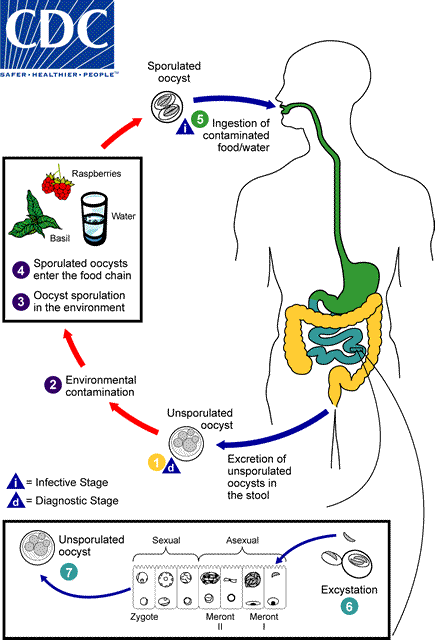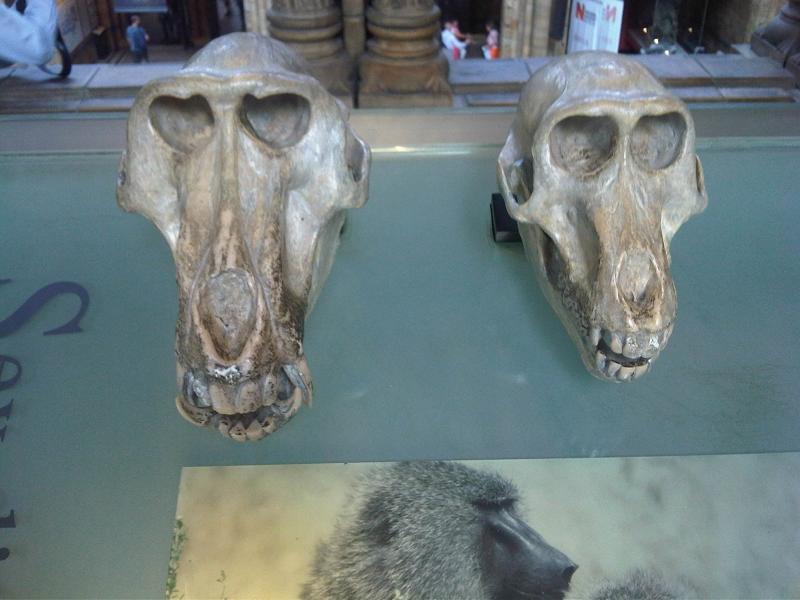|
Cyclospora Caryolytica
''Cyclospora'' is a genus of apicomplexan parasites. It includes the species ''Cyclospora cayetanensis'', the causative agent of cyclosporiasis. Members of ''Cyclospora'' are characterized as having oocysts with two sporocysts, each containing two sporozoites. Species Several ''Cyclospora'' species have been described in various mammals including: *''Cyclospora angimurinensis'' (from the Hispid pocket mouse) *''Cyclospora ashtabulensis'' (from the Hairy-tailed mole) *'' Cyclospora caryolytica'' (from various insect-eating mammals) *''Cyclospora cayetanensis'' (from humans) *''Cyclospora cercopitheci'' (from African green monkeys) *''Cyclospora colobi'' (from the Colobus monkey) *''Cyclospora megacephali'' (from the Eastern mole) *''Cyclospora papionis'' (from the Olive baboon) *''Cyclospora parascalopi'' (from the Hairy-tailed mole) *''Cyclospora talpae'' (from the European mole) A smaller number of species have been described from reptiles, arthropods, and snakes: *'' Cyclospo ... [...More Info...] [...Related Items...] OR: [Wikipedia] [Google] [Baidu] |
Cyclospora Cayetanensis
''Cyclospora cayetanensis'' is a coccidian parasite that causes a diarrheal disease called cyclosporiasis in humans and possibly in other primates. Originally reported as a novel pathogen of probable coccidian nature in the 1980s and described in the early 1990s, it was virtually unknown in developed countries until awareness increased due to several outbreaks linked with fecally contaminated imported produce. ''C. cayetanensis'' has since emerged as an endemic cause of diarrheal disease in tropical countries and a cause of traveler's diarrhea and food-borne infections in developed nations. This species was placed in the genus '' Cyclospora'' because of the spherical shape of its sporocysts. The specific name refers to the Cayetano Heredia University in Lima, Peru, where early epidemiological and taxonomic work was done. History The first published report of ''Cyclospora cayetanensis'' in humans appears to be by Ashford (1979), who found unidentified ''Isospora''-like coccid ... [...More Info...] [...Related Items...] OR: [Wikipedia] [Google] [Baidu] |
Hispid Pocket Mouse
The hispid pocket mouse (''Chaetodipus hispidus'') is a large pocket mouse native to the Great Plains region of North America. It is a member of the genus ''Chaetodipus''. Distribution The hispid pocket mouse occurs across the Great Plains from southern North Dakota to central Mexico, and west from the Missouri River to the foot of the Rocky Mountains. It is not found in far-eastern portions of the states Kansas or Missouri. Description This mouse is one of the largest pocket mice. Its pelage is bristley (''hispidus'' means "bristley"), yellowish with black hairs interspersed above. It has a distinct, buffy lateral line and white underparts. Subspecies There are four recognized subspecies: *''Chaetodipus hispidus hispidus'' Baird, 1858:421. Type locality "Charco Escondido (Tamaulipas), Mexico, (24 leagues W. of Matamoros.)" *''Chaetodipus hispidus paradoxus'' Merriam, 1889:24. Type locality "Trego County, Kansas." (''latirostris'' Rhodes, ''conditi'' Allen are synonyms.) ... [...More Info...] [...Related Items...] OR: [Wikipedia] [Google] [Baidu] |
Cyclospora Talpae
''Cyclospora'' is a genus of apicomplexan parasites. It includes the species ''Cyclospora cayetanensis'', the causative agent of cyclosporiasis. Members of ''Cyclospora'' are characterized as having oocysts with two sporocysts, each containing two sporozoites. Species Several ''Cyclospora'' species have been described in various mammals including: *'' Cyclospora angimurinensis'' (from the Hispid pocket mouse) *''Cyclospora ashtabulensis'' (from the Hairy-tailed mole) *'' Cyclospora caryolytica'' (from various insect-eating mammals) *''Cyclospora cayetanensis'' (from humans) *'' Cyclospora cercopitheci'' (from African green monkeys) *'' Cyclospora colobi'' (from the Colobus monkey) *'' Cyclospora megacephali'' (from the Eastern mole) *'' Cyclospora papionis'' (from the Olive baboon) *'' Cyclospora parascalopi'' (from the Hairy-tailed mole) *'' Cyclospora talpae'' (from the European mole) A smaller number of species have been described from reptiles, arthropods, and snakes: *'' ... [...More Info...] [...Related Items...] OR: [Wikipedia] [Google] [Baidu] |
Cyclospora Parascalopi
''Cyclospora'' is a genus of apicomplexan parasites. It includes the species ''Cyclospora cayetanensis'', the causative agent of cyclosporiasis. Members of ''Cyclospora'' are characterized as having oocysts with two sporocysts, each containing two sporozoites. Species Several ''Cyclospora'' species have been described in various mammals including: *'' Cyclospora angimurinensis'' (from the Hispid pocket mouse) *''Cyclospora ashtabulensis'' (from the Hairy-tailed mole) *'' Cyclospora caryolytica'' (from various insect-eating mammals) *''Cyclospora cayetanensis'' (from humans) *'' Cyclospora cercopitheci'' (from African green monkeys) *'' Cyclospora colobi'' (from the Colobus monkey) *'' Cyclospora megacephali'' (from the Eastern mole) *'' Cyclospora papionis'' (from the Olive baboon) *'' Cyclospora parascalopi'' (from the Hairy-tailed mole) *''Cyclospora talpae'' (from the European mole) A smaller number of species have been described from reptiles, arthropods, and snakes: *'' C ... [...More Info...] [...Related Items...] OR: [Wikipedia] [Google] [Baidu] |
Olive Baboon
The olive baboon (''Papio anubis''), also called the Anubis baboon, is a member of the family Cercopithecidae Old World monkeys. The species is the most wide-ranging of all baboons, being native to 25 countries throughout Africa, extending from Mali eastward to Ethiopia and Tanzania. Isolated populations are also present in some mountainous regions of the Sahara. It inhabits savannahs, steppes, and forests. The common name is derived from its coat colour, which is a shade of green-grey at a distance. A variety of communications, vocal and non-vocal, facilitate a complex social structure. Characteristics The olive baboon is named for its coat, which, at a distance, is a shade of green-grey. At closer range, its coat is multicoloured, due to rings of yellow-brown and black on the hairs. The hair on the baboon's face is coarser and ranges from dark grey to black. This coloration is shared by both sexes, although males have a mane of longer hair that tapers down to ordinary length ... [...More Info...] [...Related Items...] OR: [Wikipedia] [Google] [Baidu] |
Cyclospora Papionis
''Cyclospora'' is a genus of apicomplexan parasites. It includes the species ''Cyclospora cayetanensis'', the causative agent of cyclosporiasis. Members of ''Cyclospora'' are characterized as having oocysts with two sporocysts, each containing two sporozoites. Species Several ''Cyclospora'' species have been described in various mammals including: *'' Cyclospora angimurinensis'' (from the Hispid pocket mouse) *''Cyclospora ashtabulensis'' (from the Hairy-tailed mole) *'' Cyclospora caryolytica'' (from various insect-eating mammals) *''Cyclospora cayetanensis'' (from humans) *'' Cyclospora cercopitheci'' (from African green monkeys) *'' Cyclospora colobi'' (from the Colobus monkey) *'' Cyclospora megacephali'' (from the Eastern mole) *'' Cyclospora papionis'' (from the Olive baboon) *''Cyclospora parascalopi'' (from the Hairy-tailed mole) *''Cyclospora talpae'' (from the European mole) A smaller number of species have been described from reptiles, arthropods, and snakes: *'' Cy ... [...More Info...] [...Related Items...] OR: [Wikipedia] [Google] [Baidu] |
Eastern Mole
The Eastern Mole or Common Mole (''Scalopus aquaticus'') is a medium-sized North American mole. It is the only member of genus ''Scalopus''. It is found in forested and open areas with moist sandy soils in northern Mexico, the eastern United States and the southwestern corner of Ontario in Canada. The eastern mole has grey-brown fur with silver-grey underparts, a pointed nose and a short tail. It is about in length including a long tail and weighs about . Its front paws are broad and spade-shaped, specialized for digging. It has 36 teeth. Its eyes are covered by fur and its ears are not visible. The eastern mole spends most of its time underground, foraging in shallow burrows for earthworms, grubs, beetles, insect larvae and some plant matter. It is active year-round. It is mainly solitary except during mating in early spring. The female has a litter of two to five young in a deep underground burrow. Subspecies A majority of the moles throughout their range are ''Scalopus ... [...More Info...] [...Related Items...] OR: [Wikipedia] [Google] [Baidu] |
Cyclospora Megacephali
''Cyclospora'' is a genus of apicomplexan parasites. It includes the species ''Cyclospora cayetanensis'', the causative agent of cyclosporiasis. Members of ''Cyclospora'' are characterized as having oocysts with two sporocysts, each containing two sporozoites. Species Several ''Cyclospora'' species have been described in various mammals including: *'' Cyclospora angimurinensis'' (from the Hispid pocket mouse) *''Cyclospora ashtabulensis'' (from the Hairy-tailed mole) *'' Cyclospora caryolytica'' (from various insect-eating mammals) *''Cyclospora cayetanensis'' (from humans) *'' Cyclospora cercopitheci'' (from African green monkeys) *'' Cyclospora colobi'' (from the Colobus monkey) *'' Cyclospora megacephali'' (from the Eastern mole) *''Cyclospora papionis'' (from the Olive baboon) *''Cyclospora parascalopi'' (from the Hairy-tailed mole) *''Cyclospora talpae'' (from the European mole) A smaller number of species have been described from reptiles, arthropods, and snakes: *'' Cyc ... [...More Info...] [...Related Items...] OR: [Wikipedia] [Google] [Baidu] |
Colobus Monkey
Black-and-white colobuses (or colobi) are Old World monkeys of the genus ''Colobus'', native to Africa. They are closely related to the red colobus monkeys of genus '' Piliocolobus''. There are five species of this monkey, and at least eight subspecies. They are generally found in high-density forests where they forage on leaves, flowers and fruit. Social groups of colobus are diverse, varying from group to group. Resident-egalitarian and allomothering relationships have been observed among the female population. Complex behaviours have also been observed in this species, including greeting rituals and varying group sleeping patterns. Colobi play a significant role in seed dispersal. Etymology The word "colobus" comes from Greek (''kolobós'', "docked", "maimed"), so named because the thumb is stump-like. Taxonomy *Genus ''Colobus'' **Black colobus, ''C. satanas'' ***Gabon black colobus, ''C. s. anthracinus'' ***Bioko black colobus, ''C. s. satanas'' **Angola colobus, ''C. ang ... [...More Info...] [...Related Items...] OR: [Wikipedia] [Google] [Baidu] |
Cyclospora Colobi
''Cyclospora'' is a genus of apicomplexan parasites. It includes the species ''Cyclospora cayetanensis'', the causative agent of cyclosporiasis. Members of ''Cyclospora'' are characterized as having oocysts with two sporocysts, each containing two sporozoites. Species Several ''Cyclospora'' species have been described in various mammals including: *'' Cyclospora angimurinensis'' (from the Hispid pocket mouse) *''Cyclospora ashtabulensis'' (from the Hairy-tailed mole) *'' Cyclospora caryolytica'' (from various insect-eating mammals) *''Cyclospora cayetanensis'' (from humans) *'' Cyclospora cercopitheci'' (from African green monkeys) *'' Cyclospora colobi'' (from the Colobus monkey) *''Cyclospora megacephali'' (from the Eastern mole) *''Cyclospora papionis'' (from the Olive baboon) *''Cyclospora parascalopi'' (from the Hairy-tailed mole) *''Cyclospora talpae'' (from the European mole) A smaller number of species have been described from reptiles, arthropods, and snakes: *'' Cycl ... [...More Info...] [...Related Items...] OR: [Wikipedia] [Google] [Baidu] |
African Green Monkey
''Chlorocebus'' is a genus of medium-sized primates from the family of Old World monkeys. Six species are currently recognized, although some people classify them all as a single species with numerous subspecies. Either way, they make up the entirety of the genus ''Chlorocebus''. Confusingly, the terms "vervet monkey" and "green monkey" are sometimes used to refer to the whole genus ''Chlorocebus'', though they also refer more precisely to species ''Chlorocebus pygerythrus'' and '' Chlorocebus sabaeus'', respectively, neither of which is the type species for ''Chlorocebus''. This article uses the term ''Chlorocebus'' consistently for the genus and the common names only for the species. The native range of these monkeys is sub-Saharan Africa from Senegal and Ethiopia south to South Africa. However, in previous centuries, a number of them were taken as pets by early Caribbean settlers and slave traders, and were transported across the Atlantic Ocean to the Caribbean islands. Th ... [...More Info...] [...Related Items...] OR: [Wikipedia] [Google] [Baidu] |
Cyclospora Cercopitheci
''Cyclospora'' is a genus of apicomplexa The Apicomplexa (also called Apicomplexia) are a large phylum of parasitic alveolates. Most of them possess a unique form of organelle that comprises a type of non-photosynthetic plastid called an apicoplast, and an apical complex structure. Th ...n parasites. It includes the species ''Cyclospora cayetanensis'', the causative agent of cyclosporiasis. Members of ''Cyclospora'' are characterized as having oocysts with two Apicomplexan life cycle, sporocysts, each containing two sporozoites. Species Several ''Cyclospora'' species have been described in various mammals including: *''Cyclospora angimurinensis'' (from the Hispid pocket mouse) *''Cyclospora ashtabulensis'' (from the Hairy-tailed mole) *''Cyclospora caryolytica'' (from various insect-eating mammals) *''Cyclospora cayetanensis'' (from humans) *''Cyclospora cercopitheci'' (from African green monkeys) *''Cyclospora colobi'' (from the Colobus monkey) *''Cyclospora megacephali'' ( ... [...More Info...] [...Related Items...] OR: [Wikipedia] [Google] [Baidu] |


_skeleton_2.jpg)

